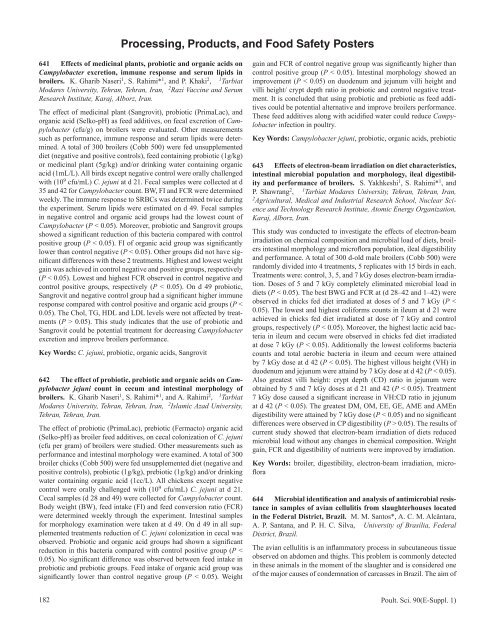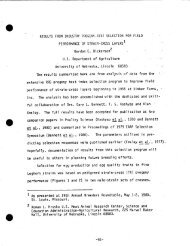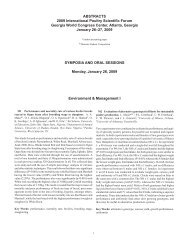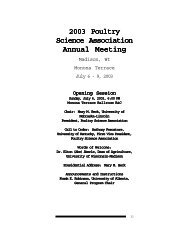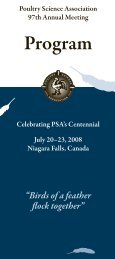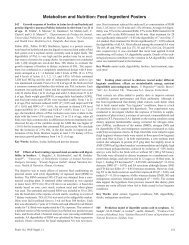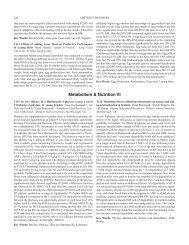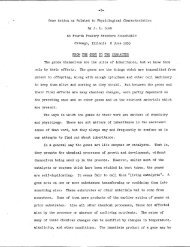Processing, Products, and Food Safety Posters - Poultry Science ...
Processing, Products, and Food Safety Posters - Poultry Science ...
Processing, Products, and Food Safety Posters - Poultry Science ...
You also want an ePaper? Increase the reach of your titles
YUMPU automatically turns print PDFs into web optimized ePapers that Google loves.
<strong>Processing</strong>, <strong>Products</strong>, <strong>and</strong> <strong>Food</strong> <strong>Safety</strong> <strong>Posters</strong><br />
641 Effects of medicinal plants, probiotic <strong>and</strong> organic acids on<br />
Campylobacter excretion, immune response <strong>and</strong> serum lipids in<br />
broilers. K. Gharib Naseri 1 , S. Rahimi* 1 , <strong>and</strong> P. Khaki 2 , 1 Tarbiat<br />
Modares University, Tehran, Tehran, Iran, 2 Razi Vaccine <strong>and</strong> Serum<br />
Research Institute, Karaj, Alborz, Iran.<br />
The effect of medicinal plant (Sangrovit), probiotic (PrimaLac), <strong>and</strong><br />
organic acid (Selko-pH) as feed additives, on fecal excretion of Campylobacter<br />
(cfu/g) on broilers were evaluated. Other measurements<br />
such as performance, immune response <strong>and</strong> serum lipids were determined.<br />
A total of 300 broilers (Cobb 500) were fed unsupplemented<br />
diet (negative <strong>and</strong> positive controls), feed containing probiotic (1g/kg)<br />
or medicinal plant (5g/kg) <strong>and</strong>/or drinking water containing organic<br />
acid (1mL/L). All birds except negative control were orally challenged<br />
with (10 9 cfu/mL) C. jejuni at d 21. Fecal samples were collected at d<br />
35 <strong>and</strong> 42 for Campylobacter count. BW, FI <strong>and</strong> FCR were determined<br />
weekly. The immune response to SRBCs was determined twice during<br />
the experiment. Serum lipids were estimated on d 49. Fecal samples<br />
in negative control <strong>and</strong> organic acid groups had the lowest count of<br />
Campylobacter (P < 0.05). Moreover, probiotic <strong>and</strong> Sangrovit groups<br />
showed a significant reduction of this bacteria compared with control<br />
positive group (P < 0.05). FI of organic acid group was significantly<br />
lower than control negative (P < 0.05). Other groups did not have significant<br />
differences with these 2 treatments. Highest <strong>and</strong> lowest weight<br />
gain was achieved in control negative <strong>and</strong> positive groups, respectively<br />
(P < 0.05). Lowest <strong>and</strong> highest FCR observed in control negative <strong>and</strong><br />
control positive groups, respectively (P < 0.05). On d 49 probiotic,<br />
Sangrovit <strong>and</strong> negative control group had a significant higher immune<br />
response compared with control positive <strong>and</strong> organic acid groups (P <<br />
0.05). The Chol, TG, HDL <strong>and</strong> LDL levels were not affected by treatments<br />
(P > 0.05). This study indicates that the use of probiotic <strong>and</strong><br />
Sangrovit could be potential treatment for decreasing Campylobacter<br />
excretion <strong>and</strong> improve broilers performance.<br />
Key Words: C. jejuni, probiotic, organic acids, Sangrovit<br />
642 The effect of probiotic, prebiotic <strong>and</strong> organic acids on Campylobacter<br />
jejuni count in cecum <strong>and</strong> intestinal morphology of<br />
broilers. K. Gharib Naseri 1 , S. Rahimi* 1 , <strong>and</strong> A. Rahimi 2 , 1 Tarbiat<br />
Modares University, Tehran, Tehran, Iran, 2 Islamic Azad University,<br />
Tehran, Tehran, Iran.<br />
The effect of probiotic (PrimaLac), prebiotic (Fermacto) organic acid<br />
(Selko-pH) as broiler feed additives, on cecal colonization of C. jejuni<br />
(cfu per gram) of broilers were studied. Other measurements such as<br />
performance <strong>and</strong> intestinal morphology were examined. A total of 300<br />
broiler chicks (Cobb 500) were fed unsupplemented diet (negative <strong>and</strong><br />
positive controls), probiotic (1g/kg), prebiotic (1g/kg) <strong>and</strong>/or drinking<br />
water containing organic acid (1cc/L). All chickens except negative<br />
control were orally challenged with (10 9 cfu/mL) C. jejuni at d 21.<br />
Cecal samples (d 28 <strong>and</strong> 49) were collected for Campylobacter count.<br />
Body weight (BW), feed intake (FI) <strong>and</strong> feed conversion ratio (FCR)<br />
were determined weekly through the experiment. Intestinal samples<br />
for morphology examination were taken at d 49. On d 49 in all supplemented<br />
treatments reduction of C. jejuni colonization in cecal was<br />
observed. Probiotic <strong>and</strong> organic acid groups had shown a significant<br />
reduction in this bacteria compared with control positive group (P <<br />
0.05). No significant difference was observed between feed intake in<br />
probiotic <strong>and</strong> prebiotic groups. Feed intake of organic acid group was<br />
significantly lower than control negative group (P < 0.05). Weight<br />
gain <strong>and</strong> FCR of control negative group was significantly higher than<br />
control positive group (P < 0.05). Intestinal morphology showed an<br />
improvement (P < 0.05) on duodenum <strong>and</strong> jejunum villi height <strong>and</strong><br />
villi height/ crypt depth ratio in probiotic <strong>and</strong> control negative treatment.<br />
It is concluded that using probiotic <strong>and</strong> prebiotic as feed additives<br />
could be potential alternative <strong>and</strong> improve broilers performance.<br />
These feed additives along with acidified water could reduce Campylobacter<br />
infection in poultry.<br />
Key Words: Campylobacter jejuni, probiotic, organic acids, prebiotic<br />
643 Effects of electron-beam irradiation on diet characteristics,<br />
intestinal microbial population <strong>and</strong> morphology, ileal digestibility<br />
<strong>and</strong> performance of broilers. S. Yakhkeshi 1 , S. Rahimi* 1 , <strong>and</strong><br />
P. Shawrang 2 , 1 Tarbiat Modares University, Tehran, Tehran, Iran,<br />
2 Agricultural, Medical <strong>and</strong> Industrial Research School, Nuclear <strong>Science</strong><br />
<strong>and</strong> Technology Research Institute, Atomic Energy Organization,<br />
Karaj, Alborz, Iran.<br />
This study was conducted to investigate the effects of electron-beam<br />
irradiation on chemical composition <strong>and</strong> microbial load of diets, broilers<br />
intestinal morphology <strong>and</strong> microflora population, ileal digestibility<br />
<strong>and</strong> performance. A total of 300 d-old male broilers (Cobb 500) were<br />
r<strong>and</strong>omly divided into 4 treatments, 5 replicates with 15 birds in each.<br />
Treatments were: control, 3, 5, <strong>and</strong> 7 kGy doses electron-beam irradiation.<br />
Doses of 5 <strong>and</strong> 7 kGy completely eliminated microbial load in<br />
diets (P < 0.05). The best BWG <strong>and</strong> FCR at (d 28–42 <strong>and</strong> 1–42) were<br />
observed in chicks fed diet irradiated at doses of 5 <strong>and</strong> 7 kGy (P <<br />
0.05). The lowest <strong>and</strong> highest coliforms counts in ileum at d 21 were<br />
achieved in chicks fed diet irradiated at dose of 7 kGy <strong>and</strong> control<br />
groups, respectively (P < 0.05). Moreover, the highest lactic acid bacteria<br />
in ileum <strong>and</strong> cecum were observed in chicks fed diet irradiated<br />
at dose 7 kGy (P < 0.05). Additionally the lowest coliforms bacteria<br />
counts <strong>and</strong> total aerobic bacteria in ileum <strong>and</strong> cecum were attained<br />
by 7 kGy dose at d 42 (P < 0.05). The highest villous height (VH) in<br />
duodenum <strong>and</strong> jejunum were attaind by 7 kGy dose at d 42 (P < 0.05).<br />
Also greatest villi height: crypt depth (CD) ratio in jejunum were<br />
obtained by 5 <strong>and</strong> 7 kGy doses at d 21 <strong>and</strong> 42 (P < 0.05). Treatment<br />
7 kGy dose caused a significant increase in VH:CD ratio in jejunum<br />
at d 42 (P < 0.05). The greatest DM, OM, EE, GE, AME <strong>and</strong> AMEn<br />
digestibility were attained by 7 kGy dose (P < 0.05) <strong>and</strong> no significant<br />
differences were observed in CP digestibility (P > 0.05). The results of<br />
current study showed that electron-beam irradiation of diets reduced<br />
microbial load without any changes in chemical composition. Weight<br />
gain, FCR <strong>and</strong> digestibility of nutrients were improved by irradiation.<br />
Key Words: broiler, digestibility, electron-beam irradiation, microflora<br />
644 Microbial identification <strong>and</strong> analysis of antimicrobial resistance<br />
in samples of avian cellulitis from slaughterhouses located<br />
in the Federal District, Brazil. M. M. Santos*, A. C. M. Alcântara,<br />
A. P. Santana, <strong>and</strong> P. H. C. Silva, University of Brasília, Federal<br />
District, Brazil.<br />
The avian cellulitis is an inflammatory process in subcutaneous tissue<br />
observed on abdomen <strong>and</strong> thighs. This problem is commonly detected<br />
in these animals in the moment of the slaughter <strong>and</strong> is considered one<br />
of the major causes of condemnation of carcasses in Brazil. The aim of<br />
182<br />
Poult. Sci. 90(E-Suppl. 1)
this work was to identify the agents presents in avian cellulitis lesions,<br />
perform the antibiogram <strong>and</strong> detect the genes of resistance to tetracycline<br />
(tetA, tetB, tetC). We collected 20 samples of avian cellulitis<br />
lesions from slaughterhouses located in the Federal District area,<br />
Brazil. We carried out the microbial isolation according to Koneman et<br />
al. (2001; Diagnóstico Microbiológico).The antimicrobial testing were<br />
realized by method of discodifusion for 16 antimicrobial drugs (ampicillin,<br />
cefazolin, gentamicin, Spiramycin, Doxycycline, Cephalexin,<br />
sulfonamide, cephalothin, penicillin, enrofloxacin, tetracycline, neomycin,<br />
norfloxacin, erythromycin, amoxicillin <strong>and</strong> chloramphenicol)<br />
<strong>and</strong> the detection of resistance genes was performed by PCR according<br />
to Van et al. (2008; Int. J. <strong>Food</strong> Microbiol., 124:217–223). We detected<br />
21 strains (72.41%) of Escherichia coli in all collected samples. It is<br />
important to note that in some samples more than one bacterial colony<br />
was found. All 21 E. coli strains analyzed (100%) were resistant to<br />
penicillin <strong>and</strong> spiramycin. 90.91% to sulfonamide, 81.82% to erythromycin,<br />
68.18% to amoxicillin, 59.09% to ampicillin <strong>and</strong> cephalexin,<br />
54.55% to cefhalothin. Only one colony (4.55%) was resistant to tetracycline<br />
<strong>and</strong> none were resistant to chloramphenicol. The gene Tet<br />
A was detected in the only one sample resistant to tetracycline. Our<br />
results showed that E. coli was the main agent detected in avian cellulitis<br />
lesions <strong>and</strong> suggest a possible problem of public health due the<br />
high resistance observed.<br />
Key Words: resistance, Escherichia coli, avian cellulitis<br />
645 Effect of simultaneous use of high pressure processing <strong>and</strong><br />
transglutaminase enzyme on spent hen protein isolate (SPI). D.<br />
A. Omana* <strong>and</strong> M. Betti, University of Alberta, Edmonton, Alberta,<br />
Canada.<br />
Every year millions of egg production hens become spent at the end<br />
of their laying cycle. Meat from spent hens is generally tough, less<br />
tender <strong>and</strong> poor in functional properties, because of its increased collagen<br />
content <strong>and</strong> cross linkages. Due to these problems associated with<br />
spent hen meat, it has become inevitable to find new ways for its utilization.<br />
Isolating proteins from spent hen meat is one of the approaches<br />
<strong>and</strong> improving the properties of isolated protein will help in utilizing<br />
this meat for preparation of gel type of products. In this study, protein<br />
isolation was carried out using pH shift technology. The isolated proteins<br />
were subjected to high pressure processing (400/600 MPa) at a<br />
temperature of 40°C with/without transglutaminase (TGase) enzyme<br />
(0.3%). Samples without TGase enzyme served as control. Color<br />
<strong>and</strong> textural properties of high pressure processed SPI were studied.<br />
Increase in pressure level caused significant (P < 0.05) increase in<br />
L* value, however addition of TGase enzyme did not affect lightness<br />
values. a* <strong>and</strong> b* values were unaffected by high pressure application<br />
or TGase addition. Improvement in water holding capacity of the<br />
sample was evident with enzyme treated sample as revealed by significant<br />
(P < 0.05) decrease in expressible moisture content. Textural<br />
profile analysis showed significant (P < 0.05) increase in hardness,<br />
chewiness, cohesiveness <strong>and</strong> resilience values for TGase treated samples;<br />
however increase in pressure did not affect these parameters. This<br />
study demonstrates that simultaneous use of transglutaminase enzyme<br />
<strong>and</strong> high pressure processing is of much importance in improving the<br />
functionality of SPI, especially in improving water holding capacity<br />
<strong>and</strong> gel texture.<br />
Key Words: spent hen protein isolate, high pressure processing, transglutaminase<br />
enzyme, water holding capacity, texture<br />
646 Application of high pressure processing to improve the<br />
functional properties of pale, soft, <strong>and</strong> exudative (PSE)-like turkey<br />
meat. J. T. Y. Chan, D. A. Omana*, <strong>and</strong> M. Betti, University of<br />
Alberta, Edmonton, Alberta, Canada.<br />
Turkey with pale, soft, exudative (PSE)-like condition is a major concern<br />
in the poultry industry as it affects meat quality attributes involved<br />
in the production of further processed products. PSE-like meat has<br />
pale color <strong>and</strong> reduced functionality. The objective of this study was<br />
to determine the functional <strong>and</strong> rheological properties of proteins in<br />
turkey breast meat with low <strong>and</strong> normal ultimate pH at 24 h postmortem<br />
(pH 24 ) that have been subjected to high pressure processing (HPP)<br />
<strong>and</strong> determine the optimal conditions to improve the functionality of<br />
PSE-like meat. Turkey breasts from Hybrid Toms were collected from<br />
a processing plant at 24 h postmortem. A total number of 35 breasts<br />
(26 pale <strong>and</strong> 9 normal) were selected based on lightness (L*) values.<br />
Further selection of 8 breasts from each class was made based on pH 24 .<br />
Samples were within values: pale (L* > 52, pH ≤ 5.7) <strong>and</strong> normal<br />
(46 < L* < 52, pH ≥ 6.0) <strong>and</strong> referred to as low <strong>and</strong> normal pH meat,<br />
respectively. Preparation of batters for HPP was made by comminuting<br />
turkey meat (89.5%) with water (10%) <strong>and</strong> NaCl (0.5%). Batters were<br />
subjected to 0, 50, 100, 150 AND 200 MPa pressure at 4°C for 5 min.<br />
Data obtained were analyzed using ANOVA <strong>and</strong> means were separated<br />
using Tukey′s HSD. The functional properties of low <strong>and</strong> normal pH<br />
meat control (unpressurized) samples were not different, except lower<br />
water holding capacity (WHC) in low pH meat. Pressures at 50 <strong>and</strong><br />
100 MPa caused increase in WHC of low pH meat, which may be<br />
due to significantly higher protein surface hydrophobicity (P < 0.05)<br />
<strong>and</strong> reactive sulfhydryl groups (P < 0.0001). The formation of a better<br />
gel network was evident at 50 <strong>and</strong> 100 MPa as revealed by rheology.<br />
HPP application caused increase (P < 0.05) in total protein solubility.<br />
Improvements in functionality of PSE-like turkey meat were achieved<br />
by HPP while allowing reduced amounts of salt addition <strong>and</strong> elimination<br />
of phosphates.<br />
Key Words: PSE, turkey, ultimate pH, high pressure processing, functional<br />
<strong>and</strong> rheological properties<br />
647 Effect of testosterone injection on occurrence of lipid <strong>and</strong><br />
protein oxidation in frozen stored broilers meat. S. Askari*, M. A.<br />
K. Torshizi, <strong>and</strong> F. B. Kasmani, Tarbiat Modares University, Tehran,<br />
Iran,<br />
Oxidation is a natural phenomenon coordinated with the cell metabolism.<br />
Sensitive polyunsaturated fatty acids (PUFA) or peroxidants,<br />
or a low intake of nutrients are involved in the antioxidant defense<br />
system. Generally it is accepted that oxidation of vitamins, carbohydrates,<br />
lipids, <strong>and</strong> proteins are one of the mechanisms that damage<br />
food stuffs quality, especially meat. Role of administered testosterone<br />
on antioxidants balance of cockerels is main object of present study.<br />
Total of 60 1-d-old male broiler chicks were r<strong>and</strong>omly allotted into 2<br />
treatments with 3 replicates including: control (received no testosterone)<br />
<strong>and</strong> testosterone treated (injected intramuscularly with 25 mg of<br />
testosterone enanthate at 14 d of age) groups. At end of experiment on<br />
d 42, 10 r<strong>and</strong>omly selected birds from each experimental group were<br />
sacrificed. Breast <strong>and</strong> thigh skin-less meat of each carcass were further<br />
apportioned into 2 sub-samples. The first set of samples analyzed for<br />
MDA <strong>and</strong> carbonyl occurrence freshly. The second set of meat samples<br />
were freeze stored for 30 d at −18°C, before measurement of MDA <strong>and</strong><br />
carbonyl contents. In fresh thigh samples of testosterone treated birds<br />
the MDA content was significantly higher in comparison to control<br />
(P < 0.05), while the MDA content of breast <strong>and</strong> carbonyl concen-<br />
Poult. Sci. 90(E-Suppl. 1)<br />
183
tration of both thigh <strong>and</strong> breast were not influenced by testosterone<br />
injection. The testosterone injected birds produced thigh <strong>and</strong> breast<br />
meats which were more susceptible to oxidation in lipid <strong>and</strong> protein<br />
moiety in frozen samples during 30 d storage, else in protein oxidation<br />
which did not influenced by testosterone administration. It could<br />
be concluded that injection of testosterone hormone will increase the<br />
susceptibility of broiler’s meat to lipid <strong>and</strong> protein oxidation.<br />
Key Words: testosterone, meat storage, lipid oxidation, protein oxidation<br />
648 Effect of extruded full fat soybean (EFFSB) on performance<br />
<strong>and</strong> blood constituents of broiler chickens. S. A. Mirghelenj*,<br />
A. Golian, <strong>and</strong> H. Kermanshahi, Ferdowsi University of<br />
Mashhad, Mashhad, Khorasan Razavi, Iran,<br />
An experiment was conducted to assess the effects of different levels<br />
of extruded full fat soybean (EFFSB) on blood constituents, digestive<br />
organ weights, ileal digesta viscosity <strong>and</strong> performance of broiler<br />
chickens. Full-fat soybeans (FFSB), were extruded at high temperature-short<br />
time (155°C, 15 s) with high pressure <strong>and</strong> shear forces at a<br />
feed plant <strong>and</strong> used at the levels of 0, 75, 150 <strong>and</strong> 225 g/kg in isocaloric<br />
<strong>and</strong> isonitrogenous starter, grower <strong>and</strong> finisher diets. One hundred<br />
<strong>and</strong> 90 2 d-old Ross 308 male broiler chicks were allocated to<br />
4 dietary treatments with 4 replicates of 12 birds each. Performance<br />
criteria were recorded weekly. Blood samples of one bird from each<br />
replicate were taken via wing vein <strong>and</strong> percentage of oxygen saturation<br />
(SO2%) measured with gasometric system on d 18. One bird from<br />
each replicate was slaughtered, digestive organs weighed <strong>and</strong> ileal<br />
digesta was collected to determine the viscosity on d 21. All data was<br />
analyzed using GLM procedure of SAS (9.1). The blood gasometry<br />
results showed that percentage of oxygen saturation in blood (SO2%)<br />
of control birds was significantly (P < 0.05) higher than those fed diet<br />
contained high level of EFFSB (69.83% vs. 64.43), showing that high<br />
level of EFFSB in diet, can affect blood oxygen saturation in chicks.<br />
With increasing the level of EFFSB in diet up to 225 g/kg, total body<br />
weight gain (BWG) reduced significantly (P < 0.05) but feed conversion<br />
ratio (FCR) <strong>and</strong> production number (PN) were similar in birds fed<br />
different diets. The pancreas to live bird weight increased significantly<br />
(P < 0.05) in birds fed diet contained high level of EFFSB as compared<br />
with control ones (0.420 vs. 0.502%), but gizzard, proventriculus,<br />
small intestine, ceca, liver <strong>and</strong> abdominal fat to live bird weight were<br />
similar in all birds (P > 0.05). High levels of EFFSB in diet, did not<br />
affect ileal digesta viscosity in chicks (P > 0.05). It is concluded that<br />
addition of EFFSB up to 225 g/kg diet did not have negative effects<br />
on broiler performance <strong>and</strong> ileal digeta viscosity but influenced blood<br />
SO2% <strong>and</strong> pancreas weight.<br />
Key Words: extruded full fat soybean, ileal digesta viscosity, broiler<br />
performance<br />
649 Effect of full fat soybean extruded at different temperatures<br />
on performance <strong>and</strong> blood constituents of broiler chickens.<br />
A. Golian*, S. A. Mirghelenj, H. Kermanshahi, <strong>and</strong> S. Zhaleh, Ferdowsi<br />
University of Mashhad, Mashhad, Khorasan, Iran,<br />
A study was conducted to evaluate the effect of full fat soybean<br />
(FFSB) extruded at different temperatures on blood constituents,<br />
digestive organ weights, ileal digesta viscosity <strong>and</strong> performance of<br />
broiler chickens. Full fat soybeans were extruded (EFFSB) at 145°C,<br />
155°C <strong>and</strong> 165°C for 15 s with high pressure <strong>and</strong> shear forces at a feed<br />
plant <strong>and</strong> used at the level of 150 g/kg in isocaloric <strong>and</strong> isonitrogenous<br />
starter, grower <strong>and</strong> finisher diets. One corn-soy diet was used as a control<br />
treatment with similar protein <strong>and</strong> energy. One hundred <strong>and</strong> 90 2<br />
d-old Ross 308 male, broiler chickens were allocated to 4 dietary treatments<br />
with 4 replicates of 12 birds each. Performance criteria were<br />
recorded weekly. Blood sample of one bird from each replicate was<br />
taken via wing vein <strong>and</strong> percentage of oxygen saturation (SO2%) measured<br />
with gasometric system on d 18. One bird from each replicate<br />
was slaughtered, digesta collected from ileum <strong>and</strong> digestive organs<br />
weighed on d 21. All data was analyzed using GLM procedure of SAS<br />
(9.1). The blood gasometry results showed that percentage of oxygen<br />
saturation (SO2%) <strong>and</strong> oxygen pressure (PO2, mmHg) in blood were<br />
similar in all chicks (P > 0.05) showing that extrusion temperatures<br />
did not affect oxygen saturation of chicks blood. There were not significant<br />
differences (P > 0.05) in body weight gain (BWG), feed intake<br />
(FI), feed conversion ratio (FCR) <strong>and</strong> production number (PN) of birds<br />
fed FFSB extruded at different temperatures. All digestive organs such<br />
as gizzard, proventriculus, small intestine, ceca, liver, pancreas <strong>and</strong><br />
abdominal fat to live bird weight (P > 0.05) <strong>and</strong> ileal digesta viscosity<br />
were similar in all birds (P > 0.05). It is concluded that extrusion of<br />
FFSB (150 g/kg diet) at 145°C, 155°C <strong>and</strong> 165°C did not affect performance,<br />
blood constituents, digestive organ weights <strong>and</strong> ileal digesta<br />
viscosity of broiler chicks compared with birds fed corn-soybean meal<br />
diet.<br />
Key Words: extrusion temperature, full fat soybean, broiler performance<br />
650 Improving the functionality of mechanically separated<br />
turkey meat protein isolates by enzymatic cross-linking using<br />
transglutaminase. Y. Hrynets*, D. A. Omana, <strong>and</strong> M. Betti, University<br />
of Alberta, Edmonton, Alberta, Canada.<br />
Mechanically separated turkey meat (MSTM) protein isolate is a<br />
high-protein ingredient obtained by pH-shifting extraction of MSTM.<br />
However, during the extraction process proteins undergo partial denaturation<br />
which in turn affects their functionality. A possible solution<br />
to increase the functional properties of isolated muscle protein (IMP)<br />
is by using enzymatic treatments. In this regard, transglutaminase<br />
(TGase), an enzyme which catalyzes protein cross-linking via acyltransfer<br />
reactions, may be used with the potential ability to improve the<br />
quality of products prepared from IMP. An experiment was conducted<br />
to determine the combined effect of TGase <strong>and</strong> salt (NaCl) on improving<br />
the water-holding capacity, texture <strong>and</strong> color of MSTM protein<br />
isolates. The effect of 3 levels of TGase (0.1; 0.3 <strong>and</strong> 0.5%), combined<br />
with 2 levels of salt (1.0 <strong>and</strong> 2.5%) at 2 incubation times (60 <strong>and</strong> 90<br />
min) was examined. The entire experiment was replicated at least 4<br />
times. Data were analyzed as 3 × 2 x 2 factorial ANOVA. Means were<br />
separated by using HSD Tukey′s adjustment. The study revealed that<br />
the combination of 0.5% of TGase with 2.5% of salt resulted in the<br />
lowest (P < 0.0001) level of cooking loss (4.79%). Higher salt level<br />
in combination with higher amount of TGase <strong>and</strong> longer incubation<br />
time resulted in a significant (P < 0.0001) increase of water-holding<br />
capacity <strong>and</strong> improvement of textural characteristics, including hardness<br />
<strong>and</strong> springiness. Significant (P = 0.0371) increase in lightness<br />
(L*) was also obtained from the samples prepared with higher level<br />
of TGase, salt <strong>and</strong> longer incubation time. The results of the study<br />
indicated that functionality of MSTM protein isolates might be greatly<br />
improved with the addition of salt <strong>and</strong> TGase enzyme.<br />
Key Words: mechanically separated turkey meat (MSTM) protein<br />
isolate, transglutaminase (TGase), texture, cooking loss, water-holding<br />
capacity<br />
184<br />
Poult. Sci. 90(E-Suppl. 1)
651 Antibacterial activity of plant extracts on major foodborne<br />
bacterial pathogens. N. Murali*, G. S. Kumar, <strong>and</strong> M. F. Slavik,<br />
<strong>Poultry</strong> <strong>Science</strong> Department, University of Arkansas, Fayetteville.<br />
Bacterial foodborne diseases are caused by consumption of foods<br />
contaminated with the bacteria <strong>and</strong>/or their toxins. In this study, we<br />
evaluated the antibacterial properties of different plant extracts including<br />
turmeric, lemon <strong>and</strong> different kinds of teas against 4 major bacterial<br />
foodborne agents including Campylobacter jejuni, Escherichia<br />
coli O157:H7, Salmonella enteritidis <strong>and</strong> Staphylococcus aureus. The<br />
extracts were prepared in phosphate buffered saline <strong>and</strong> were added to<br />
the bacterial cultures <strong>and</strong> incubated. Viable cell counts were made at<br />
regular intervals <strong>and</strong> the viability percentages were calculated. Out of<br />
the 12 extracts, the lemon extract was found to be most antibacterial<br />
<strong>and</strong> killed all the bacteria within 12 h of incubation. Among the bacterial<br />
pathogens, E. coli O157:H7 was most susceptible to the lemon<br />
extract <strong>and</strong> C. jejuni was the least susceptible. Turmeric was found<br />
to kill all the bacteria within 36 h of incubation <strong>and</strong> had maximum<br />
activity against S. aureus. Ten different teas were evaluated <strong>and</strong> green<br />
<strong>and</strong> white tea extracts were found to be the most effective antibacterial<br />
compounds <strong>and</strong> killed all the bacteria within 36hours of incubation.<br />
Other tea varieties including Rose of Suzhou, Sweet Fruit Garden<br />
<strong>and</strong> Silver Needle had various degrees of bactericidal effects. These<br />
results demonstrate the potential for using plant extracts, especially<br />
lemon extracts, as successful antibacterial agents. These extracts could<br />
be used as food additives to certain foods to reduce or eliminate foodborne<br />
pathogens.<br />
Key Words: foodborne bacteria, tea, turmeric, lemon, plant extract<br />
652 pH shifting processing of spent hens mince: Protein extraction<br />
optimization. H. Wang*, J. Wu, <strong>and</strong> M. Betti, University of<br />
Alberta, Edmonton, Alberta, Canada.<br />
Spent hens are referred to the hens that are at the end of their productive<br />
lives. Approximately over 144 million spent hens must be<br />
removed annually for the production <strong>and</strong> it becomes the major waste<br />
for the egg industry in US. The poultry industries face the challenge of<br />
finding an effective <strong>and</strong> economic method to deposit this protein-rich<br />
low value material. One of the alternative methods is the extraction of<br />
functional proteins from these raw materials using pH-shift technology.<br />
The experiment was conducted to study the extracting conditions<br />
of pH-shifting method to optimize the protein recovery from spent<br />
hens mince. Spent hen carcasses were manually deboned, homogenized<br />
<strong>and</strong> treated with 4 levels of pH for extraction (2.0, 2.5, 11.5,<br />
<strong>and</strong> 12.0). After homogenization, myofibrillar proteins were separated<br />
from the fat <strong>and</strong> other impurities using a refrigerated centrifuge at 3<br />
levels of centrifugation speed (7520xg, 15300xg <strong>and</strong> 25900xg) <strong>and</strong><br />
then precipitated at the isoelectric points (pH 5.2). The entire experiment<br />
was replicated 3 times resulting in 36 extractions (4 × 3 x3). The<br />
total protein content in the extraction was determined by the LECO<br />
TruSpec (N <strong>and</strong> C) analyzer. The data was analyzed using HSD Tukey<br />
′s adjustment. The highest protein yield (72–75%) was obtained with<br />
pH 2.5 at 15300xg <strong>and</strong> 25900xg centrifugation speed <strong>and</strong> the lowest at<br />
pH 11.5 (60–62%) at all 3 centrifugation speeds (P < 0.05). The higher<br />
protein yield (P < 0.05) obtained in the acidic conditions compare with<br />
the alkaline extractions could be explained by the more exposure of<br />
hydrophobic amino acid on the protein surface as indicated by the proteins<br />
solubility profile obtained in this study. As a consequence, this<br />
would promote protein aggregation during precipitation at the isoelectric<br />
point. The protein content was average about 90% (dry based).<br />
No statistical differences (P ≥ 0.05) were observed for protein content<br />
among the 4 treatments.<br />
Poult. Sci. 90(E-Suppl. 1)<br />
Key Words: pH-shifting, spent hens, myofibrillar proteins, hydrophobic<br />
groups, optimizing extracted conditions<br />
653 Consumer preference for omega-3 fatty acid enriched<br />
chicken frankfurters. S. Srinivasan 1 , B. Rathgeber* 2 , K. Thompson<br />
2 , <strong>and</strong> N. Pitts 1 , 1 Nova Scotia Agricultural College, Truro, Nova<br />
Scotia, Canada, 2 Agriculture <strong>and</strong> Agri-<strong>Food</strong> Canada, Kentville, Nova<br />
Scotia, Canada.<br />
The preparation of omega-3 enriched meat products is an emerging<br />
practice to meet consumer dem<strong>and</strong>s. The partial replacement of animal<br />
fats with omega-3 oils would produce healthier meat products provided<br />
flavor <strong>and</strong> textural properties were unchanged. The present study evaluated<br />
the effect of microencapsulated fish oil (MFO) <strong>and</strong> flaxseed oil<br />
(FSO) on consumer acceptability of chicken frankfurters. Frankfurters<br />
were prepared using skin-on chicken thigh meat, mechanically separated<br />
chicken meat, <strong>and</strong> chicken fat as the main ingredients. Six test<br />
treatments were prepared by partially replacing chicken fat with FSO<br />
or MFO at 1.2%, 2.4% <strong>and</strong> 3.6% of the batter. The control treatment<br />
contained chicken fat <strong>and</strong> no oil. Prepared frankfurters were cooked to<br />
an internal temperature of 74°C, vacuum packaged <strong>and</strong> stored overnight<br />
at 4°C. During sensory testing, 18 trained panelists were offered<br />
warm 2.5 cm long pieces of frankfurter in a balanced <strong>and</strong> r<strong>and</strong>omized<br />
order. A commercial chicken frankfurter was included in the test. Panelists<br />
were asked to record their perception of fishy flavor, hardness<br />
<strong>and</strong> juiciness on a 15 cm long line. Potable water <strong>and</strong> salt less crackers<br />
was provided as palate cleansing agents. The test was performed in<br />
duplicate over 2 d by the same panelists. Commercial <strong>and</strong> MFO frankfurters<br />
were found to be significantly (P < 0.05) harder <strong>and</strong> less juicy<br />
than other treatments. For MFO frankfurters, hardness increased <strong>and</strong><br />
juiciness decreased as the level of fish oil in the formulation increased.<br />
Panelists did not detect a fishy flavor in MFO frankfurters compared<br />
with treatments with no fish oil added. Overall, taste panelists rated<br />
the commercial <strong>and</strong> high MFO frankfurters as less acceptable than the<br />
chicken fat control but not different from the other treatments. Results<br />
of this study indicate that the inclusion of omega-3 fatty acids from<br />
MSO or FSO in chicken frankfurters does influence sensory perception.<br />
Production of omega-3 enriched frankfurters may be an excellent<br />
means to deliver healthy long-chain fatty acids to individuals who<br />
prefer not to consume marine-based foods.<br />
Key Words: chicken frankfurter, fatty acid, fish oil, flax oil, consumer<br />
654 Black bone discoloration in bone-in broiler chicken thighs.<br />
S. Singla, D. R. Korver*, <strong>and</strong> M. Betti, University of Alberta, Edmonton,<br />
Alberta, Canada.<br />
Black bone discoloration is associated with broiler chicken bone-in<br />
thighs <strong>and</strong> drums which may result in consumer rejection <strong>and</strong> financial<br />
loss to the industry. Hemoglobin leaks from inside the marrow cavity<br />
onto the bone surface <strong>and</strong> adjoining areas. The dark discoloration is<br />
caused by hemoglobin oxidation <strong>and</strong> breakdown after freezing or<br />
cooking. Myoglobin, a major muscle protein is oxidized to metmyoglobin<br />
after exposure to air resulting in also muscle discoloration especially<br />
after freezing or cooking. Oxidation state of iron in hemoglobin<br />
<strong>and</strong> myoglobin defines meat color. Research related to black bone discoloration<br />
in broilers is limited <strong>and</strong> hence our objective was to study<br />
the effect of freezing <strong>and</strong> cooking on discoloration. Bone-in thighs (n =<br />
40) were obtained from 20 whole-carcass broiler chickens bought from<br />
a supermarket. Effects of cooking (180C oven temperature, 80C core<br />
meat temperature), freezing (−20C for 4 weeks) <strong>and</strong> their interactions<br />
185
were studied. Color, heme iron, non-heme iron, myoglobin <strong>and</strong> total<br />
pigment were estimated in fresh raw, fresh cooked, frozen raw <strong>and</strong><br />
frozen cooked thighs. Data were analyzed using 2-way ANOVA using<br />
the mixed procedure of SAS. Cooking*freezing interactions were significant<br />
only for heme (P < 0.01) <strong>and</strong> non-heme iron (P < 0.01) among<br />
all the above parameters. In general, heme iron increased (P < 0.01)<br />
after freezing possibly due to pigment release from bone. Non-heme<br />
iron increased after freezing (P < 0.01) <strong>and</strong> cooking (P < 0.01) due to<br />
heme to non-heme conversion after protein denaturation. Total pigment<br />
(P < 0.01) <strong>and</strong> myoglobin (P < 0.01) decreased after cooking due<br />
to pigment breakdown <strong>and</strong> coagulation while freezing had no effect<br />
(P > 0.05). Meat was lighter in color as lightness (L*) increased (P <<br />
0.01) <strong>and</strong> redness (a*) decreased (P < 0.01) after cooking while freezing<br />
had no effect (P > 0.05). The study revealed that even though there<br />
was release of pigments, the current conditions used for cooking <strong>and</strong><br />
freezing did not lead to discoloration to a detectable level <strong>and</strong> hence<br />
had no influence in black bone discoloration.<br />
Key Words: hemoglobin, myoglobin, broilers, freezing, cooking<br />
655 Relationship between ground flaxseed-based omega-3<br />
PUFA enrichment of broiler breast meat <strong>and</strong> meat quality attributes.<br />
S. Nain*, R. A. Renema, B. L. Schneider, M. Betti, <strong>and</strong> <strong>and</strong> M.<br />
J. Zuidhof, University of Alberta, Edmonton, AB, Canada.<br />
Inclusion of flaxseed in the poultry ration is an effective method of<br />
enriching broiler meat with omega-3 polyunsaturated fatty acid (ω-3<br />
PUFA). An experiment was designed to correlate the effect of the<br />
duration of feeding ground flaxseed-based ω-3 PUFA enrichment with<br />
breast meat quality <strong>and</strong> fatty acid profile. A total of 400, 1-d-old, Ross<br />
x Ross 308 mixed-sex broilers were divided among 16 pens <strong>and</strong> fed an<br />
enriched diet containing 10% ground flaxseed for 8 time durations (0,<br />
4, 8, 12, 16, 20, 24, or 35 d) before processing at 35 d. During processing,<br />
sex was verified, <strong>and</strong> in the 64 birds allocated to this study, breast<br />
meat quality traits, including pH, texture, color, driploss <strong>and</strong> cooking<br />
loss were assessed. Each breast was shrink-wrapped <strong>and</strong> stored at −20<br />
C pending fatty acid composition analysis. The data were analyzed<br />
with SAS (P < 0.05). Breast meat fatty acids were not affected by<br />
sex of broilers. Total ω-3 PUFA after 35 d on enriched feed was 353<br />
mg/100g, which was up to 3 times the level found in Control birds (P<br />
< 0.0001). Long chain ω-3 PUFA (LC ω-3 PUFA) also increased, with<br />
docosapentaenoic acid most predominant (45% of LC ω-3 PUFA). The<br />
ω-6:ω-3 PUFA ratio in the breast at 35 d decreased in birds on the<br />
enriched (1.6) compared with the non-enriched diet (8.5). Broken stick<br />
analysis indicated 18 d of feeding 10% flaxseed is required to enrich<br />
ω-3 PUFA to the target enrichment labeling level of 300 mg/100 g of<br />
meat. However, 1 in 4 birds were unable to reach this target even with<br />
35 d on enriched diets. Bird-to-bird variability in ω-3 PUFA enrichment<br />
(measured by CV analysis) was reduced by 50% in the enriched<br />
period (20 to 35 d) compared with non-enriched period (0 to 16 d).<br />
The LNA <strong>and</strong> total ω-3 PUFA content in breast were associated with<br />
negative meat quality traits such as decreased ultimate pH (r = −0.38;<br />
P = 0.001) <strong>and</strong> increased lightness (r = 0.40; P = 0.001) <strong>and</strong> driploss<br />
(r = 0.35; P = 0.006) <strong>and</strong>, in the female, increased cooking loss (r =<br />
0.53; P = 0.001). Strategies to enrich ω-3 PUFA in broiler breast meat<br />
should include study of impact of enrichment source on meat quality.<br />
Key Words: broiler, omega-3 PUFA, breast meat, meat quality<br />
656 Models to predict specialty egg purchasers’ behavior. M.<br />
Bejaei*, K. Wiseman, <strong>and</strong> K. M. Cheng, University of British Columbia,<br />
Vancouver, BC, Canada.<br />
186<br />
Market share of specialty eggs (e.g., free-range, free-run <strong>and</strong> organic<br />
eggs) has increased more than 2 fold since 2002 in Canada (10.3%<br />
in 2002). Their market share is higher in British Columbia (BC) than<br />
across Canada. The objective of our research was to develop models<br />
to predict purchasers’ behavior with regards to white regular, brown<br />
regular, free-range, free-run, organic <strong>and</strong> nutrient enhanced eggs.<br />
Moreover, we used the models to investigate the market potentials<br />
for regular eggs (brown <strong>and</strong> white) <strong>and</strong> cage-free eggs (free-run, freerange<br />
<strong>and</strong> organic) in separate categories. An online survey was the<br />
primary research tool used to gather data for developing <strong>and</strong> testing<br />
the models. Potential subjects were r<strong>and</strong>omly selected from email<br />
addresses of adult BC residents. A total of 702 completed questionnaires<br />
were submitted online (68% response rate). Potential purchase<br />
model for each type of egg was investigated using logistic regression<br />
analysis. The outcome variable for each model was a dichotomous<br />
variable of whether consumers bought a type of egg. Predictor variables<br />
were selected (considering multicollinearity) from questions<br />
answered by survey respondents. Models resulted from our research<br />
can account for 42 to 59% of the variance in the purchase of white regular<br />
eggs, 33 to 45% of the variance in the purchase of free-range eggs<br />
<strong>and</strong> 45 to 60% of variance in the purchase of cage-free eggs (Cox &<br />
Snell, <strong>and</strong> Nagelkerke R Squares, respectively). Regular egg purchasers<br />
were more concerned about price than care <strong>and</strong> feeding of hens,<br />
used flyers to make purchase decision, preferred white shell color,<br />
had lower educational level, <strong>and</strong> bought their eggs from major chain<br />
grocery stores or local grocery stores. Cage-free egg purchasers were<br />
more concerned about care <strong>and</strong> feeding of hens than price, did not use<br />
store flyers to make the purchase decision, preferred brown shell color,<br />
were younger, <strong>and</strong> bought their eggs directly from farm, organic/local<br />
grocery stores, or major chain grocery stores. These models could be<br />
used to investigate the influence of a change in each predictor variable<br />
on the probability of purchase of a special type of egg.<br />
Key Words: specialty eggs, logistic regression, consumer characteristics,<br />
purchase models<br />
657 Enzymatic susceptibility of phosvitin for improved hydrolysis.<br />
H. Samaraweera*, E. J. Lee, <strong>and</strong> D. U. Ahn, Iowa State University,<br />
Ames.<br />
Egg yolk phosvitin is the most phosphorylated protein found in the<br />
nature. Due to phosphorylated serine moieties it shows high metal chelating,<br />
antioxidant <strong>and</strong> emulsifying properties. Phosvitin is considered<br />
as a nutritionally negative protein because it forms insoluble complexes<br />
in the presence of bivalent cations <strong>and</strong> is resistant to enzymatic<br />
digestion. If fragmented, however, the peptides containing phosphates<br />
(phosphopeptides) can greatly enhance the mineral bioavailability, <strong>and</strong><br />
thus can be exploited as mineral carrying bioactive phosphopeptides.<br />
The aim of this study was to find out an effective protease enzyme/<br />
enzyme combinations for phosvitin <strong>and</strong> to increase the protease susceptibility<br />
of phosvitin. Phosvitin was digested with trypsin, pepsin,<br />
α-chymotrypsin, enzyme protein Multifect P3000, alkalase (Bacterial<br />
alkaline protease: Protex 6L) <strong>and</strong> thermolysin (from Bacillus thermoproteolyticus<br />
Rokko) <strong>and</strong> the combinations of trypsin <strong>and</strong> pepsin,<br />
enzyme protein Multifect P3000 <strong>and</strong> α-chymotrypsin <strong>and</strong> alkalase<br />
<strong>and</strong> α-chymotrypsin. Enzymatic hydrolysates were subjected to SDS-<br />
PAGE <strong>and</strong> HPLC analysis. Also, phosvitin was treated with 0.5% <strong>and</strong><br />
1% SDS with/without temperature treatment of 100°C for 15 min.<br />
Then samples were subjected to circular dichroism to evaluate the<br />
secondary structural changes of the protein. Thermolysin hydrolysates<br />
of the treated phosvitin were evaluated by SDS-PAGE. Among<br />
the 6 enzymes tested, enzyme protein Multifect P3000 <strong>and</strong> alkalase<br />
Poult. Sci. 90(E-Suppl. 1)
showed higher protease activity on phosvitin than other 4 enzymes<br />
tested. Thermolysin activity was better than the rest of 3 enzymes.<br />
Use of enzyme combinations did not show any further digestion of the<br />
resulted phosphopeptides from the first enzymes used. SDS with <strong>and</strong><br />
without temperature treatments caused significant changes of sheet<br />
<strong>and</strong> coil structures of phosvitin. However, none of these treatments<br />
improved the enzymatic susceptibility of phosvitin. Even though SDS<br />
with <strong>and</strong> without temperature treatments resulted some structural differences<br />
in phosvitin, SDS did not improve the enzymatic digestion<br />
of phosvitin.<br />
Key Words: phosvitin, phosphorylated protein, enzymatic digestion,<br />
circular dichroism, phosphopeptides<br />
658 Effects of dietary content of corn distillers dried grains<br />
with solubles (DDGS) on the egg production <strong>and</strong> internal quality<br />
of eggs. H. Sun, E. J. Lee*, M. Persia, <strong>and</strong> D. U. Ahn, Department of<br />
Animal <strong>Science</strong>, Iowa State University, Ames<br />
The effects of DDGS as a feed ingredient on egg production, egg internal<br />
quality, <strong>and</strong> egg composition, <strong>and</strong> analyze optimal levels of DDGS<br />
for laying hens were determined. Four levels of corn DDGS (0, 17%,<br />
35%, <strong>and</strong> 50%) was used in a corn <strong>and</strong> soybean meal-based diet. A<br />
total of 256 60-week-old single-comb White Leghorn laying hens were<br />
r<strong>and</strong>omly selected, 2 birds were placed in a cage, <strong>and</strong> 3 consecutive<br />
cages were assigned as a pen. Each pen was r<strong>and</strong>omly assigned to<br />
one of the 4 diets <strong>and</strong> fed for 24 weeks. Two values of amino acid<br />
digestibility were used to form 2 diet formulas of which all meet or<br />
exceed the National Research Council nutrient recommendations for<br />
laying hens. Each diet formula was fed for 12 weeks. Egg production<br />
<strong>and</strong> feed consumption were recorded, <strong>and</strong> egg component, egg quality<br />
<strong>and</strong> its changes during storage <strong>and</strong> shell strength were measured. With<br />
formula 1, egg production, egg weight, egg mass, feed intake, <strong>and</strong> feed<br />
efficiency were the best with 0% DDGS treatment <strong>and</strong> the worst with<br />
50% DDGS treatment with no differences between 17 <strong>and</strong> 35% DDGS<br />
treatments. With formula 2, the differences among the 4 DDGS treatments<br />
were smaller than those with formula 1. No differences in egg<br />
production, egg weight, <strong>and</strong> feed intake among DDGS treatments were<br />
observed with formula 2 during the last 5 weeks of study. DDGS in<br />
diet improved yolk color, Haugh unit, <strong>and</strong> shell strength. Shell percentage<br />
also increased as DDGS levels in the diet increased, but no<br />
difference in yolk <strong>and</strong> albumen percentage was observed. The results<br />
indicated that DDGS can be included in layer diets as high as 50%<br />
without affecting egg production <strong>and</strong> egg quality. However, amino<br />
acid digestibility of DDGS must be carefully estimated to meet production<br />
need.<br />
Key Words: corn distillers dried grains with solubles, laying hen, egg<br />
production, Haugh unit, yolk color<br />
659 Influence of dietary vitamin E supplementation on shelf life<br />
of ground broiler chicken meat during frozen storage. B. Saenmahayak*,<br />
M. Singh, J. B. Hess, <strong>and</strong> S. F. Bilgili, Auburn University,<br />
Auburn, AL.<br />
This study was conducted to determine the microbial spoilage <strong>and</strong> oxidative<br />
stability of ground raw <strong>and</strong> cooked breast <strong>and</strong> thigh meat from<br />
broiler chickens fed graded levels of vitamin E during frozen storage.<br />
A total of 480 female broilers were assigned to 4 dietary vitamin E<br />
treatments (IU/kg of feed): 30 (basal level), 60, 120 <strong>and</strong> 240. Each<br />
of the 4 dietary treatments was fed in a 3 stage feeding program to 12<br />
replicate pens of 10 birds <strong>and</strong> reared to 49 d of age. Upon processing,<br />
one-half of the replicate pens from each dietary treatment were used<br />
for raw <strong>and</strong> the other half for cooked meat treatments. Boneless-skinless<br />
breast <strong>and</strong> thigh meat (5 birds per pen) was ground, pooled by pen,<br />
formed into patties, vacuum packaged (oxygen impermeable) either<br />
raw or cooked (internal temperature of 80°C), <strong>and</strong> held under −18°C.<br />
Samples were analyzed for microbial spoilage (aerobic plate counts;<br />
APC, lactic acid bacteria; LAB, <strong>and</strong> yeast <strong>and</strong> molds; YAM) <strong>and</strong> lipid<br />
oxidation (TBARS) following 6, 12, 24, 48 d of frozen storage. Microbial<br />
numbers increased with storage time in both raw breast <strong>and</strong> thigh<br />
meat, with APC counts remained lower (3 log 10 cfu/g) after 48 d of<br />
storage. Cooking reduced microbial counts <strong>and</strong> slowed the rate of<br />
microbial growth in breast <strong>and</strong> thigh meat during frozen storage. Vitamin<br />
E supplementation affected microbial counts only for raw breast<br />
(APC on 12 d; 0.84 cfu/g) <strong>and</strong> raw thigh (LAB on 12 d; 0.63 cfu/g),<br />
with levels of 240 IU/kg significantly impeding microbial growth as<br />
compared with basal levels. Lipid oxidation increased during frozen<br />
storage on both raw <strong>and</strong> cooked ground meat (breast < thigh). Dietary<br />
vitamin E supplementation at levels more than 120 IU/kg significantly<br />
reduced the rate of lipid oxidation in cooked ground breast <strong>and</strong> thigh<br />
meat as compared with the basal level (4.18 <strong>and</strong> 4.94 mg MDA/kg of<br />
meat). In this study, oxidative changes that occur during frozen storage<br />
of ground cooked broiler meat appeared to correlate <strong>and</strong> were positively<br />
influenced by dietary vitamin E supplementation.<br />
Key Words: vitamin E, shelf-life, lipid oxidation<br />
660 Influence of growth rate on the occurrence of white striping<br />
in broiler breast fillets. V. A. Kuttappan*, V. B. Brewer, P. W.<br />
Waldroup, <strong>and</strong> C. M. Owens, University of Arkansas, Fayetteville.<br />
The occurrence of white striping on breast fillets is mainly associated<br />
with heavier broiler birds. It has been found that the condition<br />
can result in significant reduction of the consumer acceptance of the<br />
breast fillets. The objective of the study was to estimate the occurrence<br />
of normal (NORM), moderate (MOD) <strong>and</strong> severe (SEV) degrees of<br />
white striping with respect to the growth rate of broilers. Low <strong>and</strong> high<br />
nutrient diets, based on Rostagno et al. (2005) recommendations, were<br />
used to obtain slow or rapid growth patterns in the birds. Straightrun<br />
day old chicks (n = 280) were r<strong>and</strong>omly assigned to either low or<br />
high nutrient diet treatments. There were 5 replicates for each treatment,<br />
with 28 birds each. Birds were processed at an age of 54 d. Live<br />
weight, deboned fillet weight <strong>and</strong> the occurrence of the 3 degrees of<br />
white striping were recorded. The birds grown on a high nutrient diet<br />
showed a significantly (P < 0.05) lower feed conversion ratio when<br />
compared with the low nutrient diet (2.08 vs 2.28, respectively) birds.<br />
Also, the high nutrient diet birds had a significantly (P < 0.05) higher<br />
live weight <strong>and</strong> fillet weight when compared with the birds on the low<br />
nutrient diet. Interestingly, the low nutrient diet birds showed a higher<br />
percentage of NORM <strong>and</strong> lower percentage of SEV white striping<br />
fillets when compared with the high nutrient diet birds. There was a<br />
significant (P < 0.05) increase in fillet weight <strong>and</strong> fillet yield (percent<br />
of live weight) as the degree of white striping increased from NORM<br />
to SEV. These data suggest that an increased growth rate can result in<br />
increased occurrence of white striping in broiler breast fillets.<br />
Key Words: White striping, low <strong>and</strong> high nutrient diets, growth rate,<br />
broiler breast fillets, increased occurrence<br />
661 Impact of further processing on dielectric properties of<br />
broiler poultry meat. D. Samuel* <strong>and</strong> S. Trabelsi, Russell Research<br />
Center, Athens, GA.<br />
Poult. Sci. 90(E-Suppl. 1)<br />
187
Currently in the US more than 90% of the turkeys <strong>and</strong> more than 70%<br />
of the broilers are processed beyond the normal ready-to-cook stage.<br />
Up to 50% of raw poultry meat is marinated with mixtures of water,<br />
salts, <strong>and</strong> phosphates. Physical properties of foods provide essential<br />
data to the food industry <strong>and</strong> can be used in the design, installation,<br />
operation <strong>and</strong> control of processes, plant <strong>and</strong> equipment used in food<br />
processing. Dielectric properties of foods are the electrical properties<br />
which strongly influence the temperature distribution of food during<br />
radio frequency <strong>and</strong> microwave heating. The objective of this research<br />
was to examine the effect of 2 commonly practiced further processing<br />
techniques (grinding <strong>and</strong> marination) on the dielectric properties<br />
of broiler poultry meat. All poultry meat was obtained from a local<br />
commercial processing plant. Dielectric properties of all samples were<br />
obtained utilizing an Agilent 85070A open-ended coaxial-line probe<br />
connected to an N5230C PNA L-Network Analyzer. Measurements<br />
were collected at 501 frequencies on a logarithmic scale from 500<br />
MHz to 50 GHz. To evaluate effect of grinding on dielectric properties,<br />
measurements were conducted on ground <strong>and</strong> whole muscle.<br />
t-tests showed that ground muscle (a common ingredient in further<br />
processed meats) exhibited lower dielectric properties than the whole<br />
muscle (P < 0.001). To examine the effect of marination on dielectric<br />
properties, groups of breast filets were sorted into classes of pale,<br />
normal <strong>and</strong> dark before adding marination pickup percentages of 0, 5,<br />
10, <strong>and</strong> 15. Data was analyzed using Sigma Plot. Overall, dielectric<br />
properties increased as the pickup percentage increased. Differences<br />
between samples were more pronounced at lower frequencies for the<br />
loss factor. Differences in dielectric constant between samples were<br />
less significant. The dielectric properties of poultry meat were significantly<br />
affected by the 2 processes.<br />
Key Words: broilers, further processing, marination, dielectric properties,<br />
frequency<br />
662 Salmonella spp., Escherichia coli <strong>and</strong> Campylobacter spp.<br />
in chickens: Updates on antimicrobial resistance trends, patterns<br />
<strong>and</strong> recovery rates in Canada. A. Agunos*, B. Avery, C. Carson, A.<br />
Deckert, L. Dutil, S. Gow, D. Légrr, J. Parmley, M. Tessier, R. Reid-<br />
Smith, <strong>and</strong> R. Irwin, Laboratory for <strong>Food</strong>borne Zoonoses, Public<br />
Health Agency of Canada.<br />
AAAP abstract†<br />
663 The effects of Cordyceps fermented products on the production<br />
performance <strong>and</strong> the protection against infection of Salmonella<br />
Enteritidis in laying hens. T. T. Chen* 1 , C. Chu 2 , B. C.<br />
Weng 2 , <strong>and</strong> K. L. Chen 3 , 1 Graduate Institute of Agriculture, National<br />
Chiayi University, Chiayi City, Taiwan, 2 Microbiology <strong>and</strong> Immunology,<br />
National Chiayi University, Chiayi City, Taiwan, 3 Animal <strong>Science</strong>,<br />
National Chiayi University, Chiayi City, Taiwan.<br />
The purpose of this study is to investigate the effects of different fermented<br />
Cordyceps products on the production performance, immune<br />
response <strong>and</strong> the protection against infection of Salmonella Enteritidis<br />
in laying hens. One hundred 39-week-old selected Hy-Line W36 hens<br />
() were r<strong>and</strong>omly allocated into 5 dietary groups with 5 replicates for<br />
a 20 weeks feeding experiment. Diets were supplemented with 0% or<br />
0.3% submerged Acremonium implicatum fermented products (AIFP),<br />
<strong>and</strong> wheat, oat <strong>and</strong> barley based solid Cordyceps militaris fermented<br />
products (CMW, CMO <strong>and</strong> CMB). The functions of peripheral blood<br />
mononuclear cell <strong>and</strong> polymorphonuclear granulocyte (PMN) were<br />
analyzed at the 10th week. To evaluate the protection of these different<br />
feedings, each hen was then intraperitioneally challenged with 1 × 10<br />
5<br />
SE equal to half LD 50 . In the first 10 weeks feeding period (before<br />
challenge), the highest egg mass was observed in CMB with a difference<br />
than the control group (P < 0.05), whereas CMW <strong>and</strong> AIFP were<br />
falling in the middle. After LPS treatment, PMN isolated from the hens<br />
of CMO group showed the highest oxidative burst (P < 0.05). After<br />
challenge with SE, in contrast to highest mortality in the control group<br />
(40.0%), the lowest mortality was found in CMO group (16.7%), followed<br />
by CMB, AIFP, <strong>and</strong> CMW (21.1–26.3%). There was no any<br />
significant difference in SE contaminations in egg contents <strong>and</strong> shell<br />
membranes (P > 0.05). However, better recovery in production performance<br />
was obtained in the supplemental groups. In contrast to egg<br />
mass <strong>and</strong> feed intake/egg mass in control group, CMB group showed<br />
18.5% <strong>and</strong> 17.2% increase in both performances. In conclusion, diet<br />
supplementary with 0.3% barley based Cordyceps militaris fermented<br />
products showed the best egg mass before challenge, <strong>and</strong> the lower<br />
mortality <strong>and</strong> the better performance recovery after challenge with half<br />
LD 50 of SE.<br />
Key Words: barley, Cordyceps militaris, fermented products, laying<br />
hens, Salmonella Enteritidis<br />
†This abstract from the American Association of Avian Pathologists (AAAP) is available in the AVMA Convention Notes at<br />
www.avmaconvention.org <strong>and</strong> at www.aaap.info/2011meeting.<br />
188<br />
Poult. Sci. 90(E-Suppl. 1)


